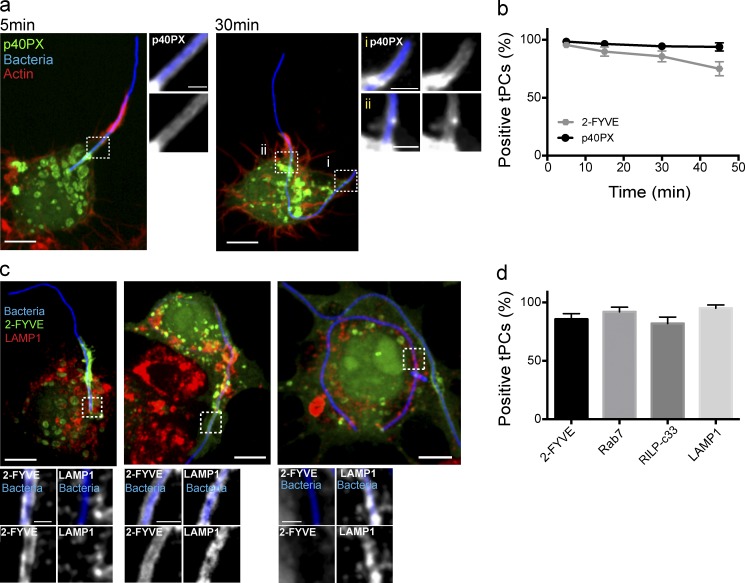Figure 2.
PtdIns(3)P coexists with late endosomal markers at tPCs. (a) p40PX-GFP (green) recruitment to the base of tPCs in RAW macrophages engulfing filamentous bacteria (blue) at indicated time points. Actin jackets, denoted by F-actin accumulation (red), delineate the top border of the phagocytic cup. Main panels show representative images of merged z-stacks, and images to the right of each main panel show magnified single planes from framed regions showing recruitments of p40PX-GFP to tPCs. (b) Recruitment of 2-FYVE-GFP and p40PX-GFP, indicative of the presence of PtdIns(3)P around tPCs. Cells transiently expressing either 2-FYVE-GFP or p40PX-GFP were scored for partially internalized filamentous bacteria positive for PtdIns(3)P. Data shown are means ± SEMs from three independent experiments (n = 30 for each time point). (c) RAW macrophages expressing 2-FYVE-GFP were challenged with filamentous bacteria, fixed, permeabilized, and immunostained for LAMP1. Left and middle panels show partially internalized bacteria. Right panel depicts fully internalized bacteria. Main panels are merged z-stacks, and images at the bottom show single planes from framed regions. Bars: 5 µm; (enlarged areas) 1 µm. (d) Number of tPCs positive for 2-FYVE, LAMP1, Rab7, and RILP-C33 recruitment at 30 min after the onset of phagocytosis. Cells expressing 2-FYVE-GFP, GFP-Rab7, or RILP-C33-GFP or immunostained for LAMP1 were scored for partially internalized filamentous bacteria. tPCs were scored positive for markers if labeling was observed along the entirety of the cup. Data shown are means ± SEMs of percentages from three independent experiments (n = 30 for each).

